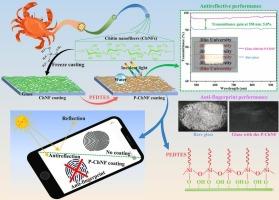基于几丁质纳米纤维的触摸屏防指纹防反射涂层的制备与表征
IF 12.5
1区 化学
Q1 CHEMISTRY, APPLIED
引用次数: 0
摘要
触摸屏界面和便携式电子产品的快速发展增加了对抗指纹和抗反射涂层的需求,这些涂层可以增强屏幕可视性,改善用户的视觉体验。然而,现有的亲油或拒油涂层在实际使用条件下往往无法提供高透明度和持久的抗指纹性能。在这项研究中,制备了一种基于几丁质纳米纤维(ChNFs)的防反射涂层,为触摸屏显示器提供双疏和防指纹保护。采用冷冻铸造和PFDTES沉积改性的方法制备了具有大量纳米孔的chnf基涂层。pfdes改性甲壳素纳米纤维(P-ChNF)涂层结合了水和油酸接触角分别为153°和118°的抗指纹性能,并将550 nm处的玻璃透过率提高了约5%。P-ChNF涂层具有良好的环境耐久性和机械坚固性,在恶劣条件下仍能保持其抗指纹和抗反射性能。值得注意的是,涂有P-ChNF的智能手机屏幕显示指纹残留大幅减少,证实了抗指纹性能的提高。这项工作不仅表明chfs是满足触摸屏显示器日益增长的保护涂层需求的有希望的候选材料,而且为实现这一目标提供了可行和高效的策略,从而促进防指纹涂层行业的绿色和可持续发展。本文章由计算机程序翻译,如有差异,请以英文原文为准。

Preparation and characterization of anti-fingerprint and antireflective coatings prepared for touchscreen displays based on chitin nanofibers
The rapid development of touchscreen interfaces and portable electronics has increased the demand for anti-fingerprint and antireflective coatings, which enhance screen visibility and improve the user's visual experience. However, existing oleophilic or oil-repellent coatings often fail to deliver both high transparency and durable anti-fingerprint performance under real-use conditions. In this study, an antireflective coating was fabricated based on chitin nanofibers (ChNFs) to provide both amphiphobic and anti-fingerprint protection for touchscreen displays. The ChNF-based coatings with abundant large-sized nanopores were fabricated via freeze casting and subsequent modification with PFDTES deposition. The PFDTES-modified chitin nanofiber (P-ChNF) coatings combined the anti-fingerprint performance of both water and oleic acid contact angles of 153° and 118°, and increased glass transmittance at 550 nm by ∼5 %. The P-ChNF coatings possessed good environmental durability and mechanical robustness, maintaining their anti-fingerprint and antireflective properties under harsh conditions. Notably, the smartphone screen coated with P-ChNF exhibited a substantial reduction in fingerprint residue, confirming improved anti-fingerprint performance. This work not only demonstrates that ChNFs are a promising candidate for meeting the growing demand for protective coatings in touchscreen displays, but also offers a feasible and efficient strategy to do so, thereby promoting the green and sustainable development of the anti-fingerprint coating industry.
求助全文
通过发布文献求助,成功后即可免费获取论文全文。
去求助
来源期刊

Carbohydrate Polymers
化学-高分子科学
CiteScore
22.40
自引率
8.00%
发文量
1286
审稿时长
47 days
期刊介绍:
Carbohydrate Polymers stands as a prominent journal in the glycoscience field, dedicated to exploring and harnessing the potential of polysaccharides with applications spanning bioenergy, bioplastics, biomaterials, biorefining, chemistry, drug delivery, food, health, nanotechnology, packaging, paper, pharmaceuticals, medicine, oil recovery, textiles, tissue engineering, wood, and various aspects of glycoscience.
The journal emphasizes the central role of well-characterized carbohydrate polymers, highlighting their significance as the primary focus rather than a peripheral topic. Each paper must prominently feature at least one named carbohydrate polymer, evident in both citation and title, with a commitment to innovative research that advances scientific knowledge.
 求助内容:
求助内容: 应助结果提醒方式:
应助结果提醒方式:


